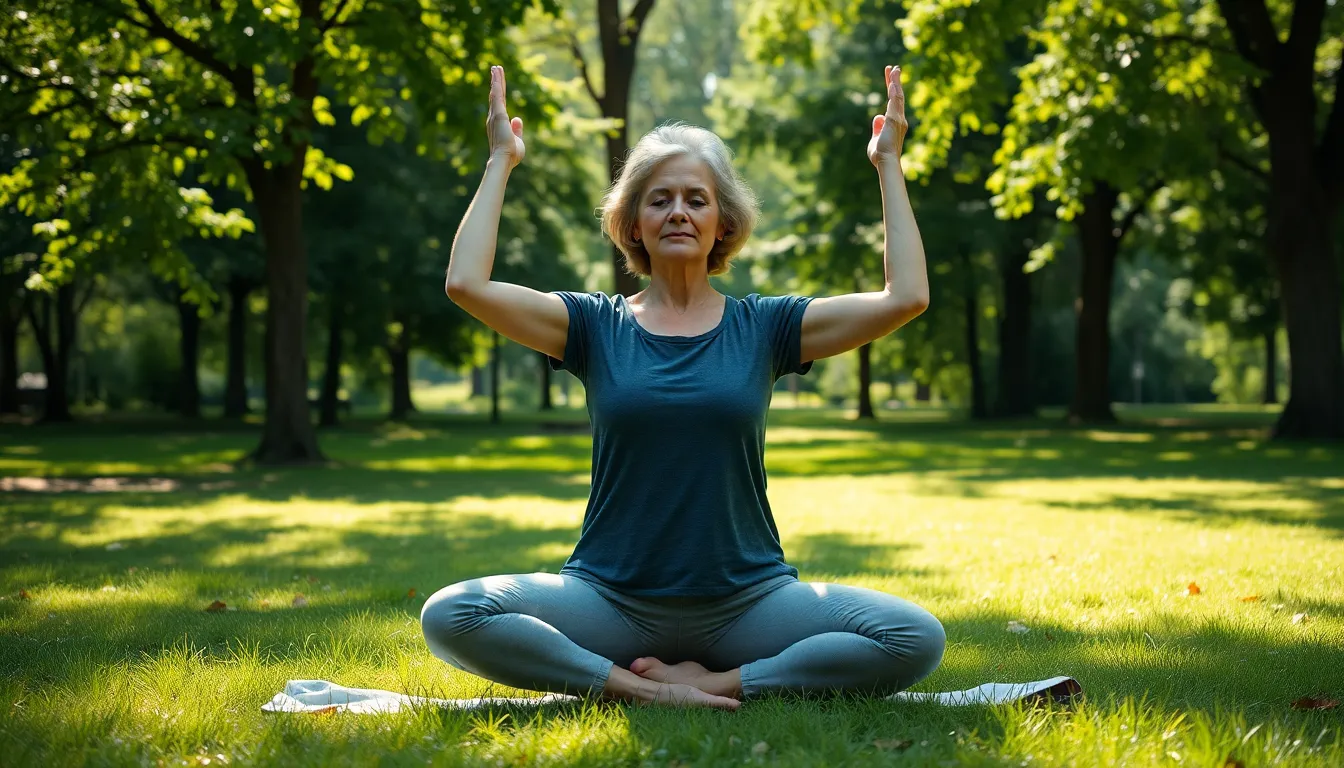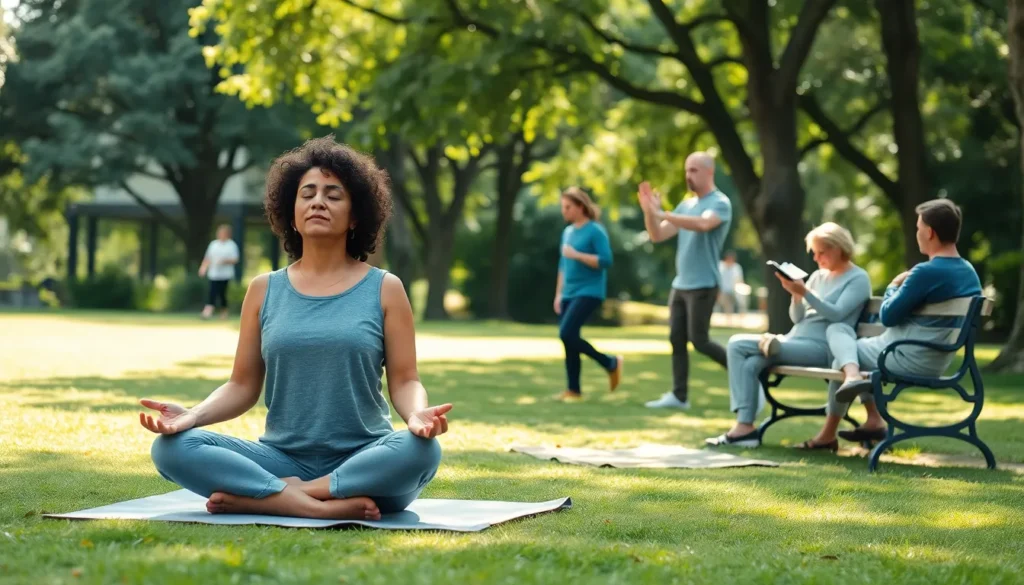In a world buzzing with distractions, mindfulness practices offer a refreshing escape. Imagine sipping a warm cup of tea while the chaos of life swirls around you. With various types of mindfulness techniques, finding your perfect fit is like discovering the ideal pair of sweatpants—comfortable and just right for you.
Table of Contents
ToggleOverview of Mindfulness Practices
Mindfulness practices encompass various techniques designed to cultivate present-moment awareness. These methods help individuals focus on their thoughts, feelings, and surroundings while minimizing distractions. Popular approaches include meditation, breathing exercises, and mindful movement.
Meditation serves as a foundational practice for many. Different styles exist, such as focused attention, open monitoring, and loving-kindness meditation. Each style offers unique benefits, from enhanced concentration to increased compassion.
Breathing exercises provide another effective technique. Deep breathing, box breathing, and diaphragmatic breathing are common forms. Practitioners can use these methods to reduce stress and promote relaxation by simply focusing on their breath.
Mindful movement encompasses activities like yoga, tai chi, and qigong. These practices blend physical movement with awareness, encouraging participants to connect with their bodies and emotions. Engaging in mindful movement can increase flexibility and enhance mental clarity.
Walking meditations also fall under mindfulness practices. Participants focus on the sensations of each step while being aware of their surroundings. This technique blends physical exercise with mental engagement.
Journaling as a form of mindfulness encourages individuals to reflect on their thoughts. By writing down feelings and experiences, people gain clarity and insight into their emotional states. This practice can be particularly helpful for those processing complex emotions.
Several other techniques exist, including body scans, mindful eating, and progressive muscle relaxation. Each offers distinct methods to enhance awareness and foster a sense of peace. Individuals may find that trying various practices helps identify the most suitable approach for their needs.
Types of Mindfulness Practices

Mindfulness practices vary in form and approach, catering to different preferences and lifestyles. Understanding the distinctions between formal and informal practices helps individuals choose what resonates best.
Formal Practices
Formal practices often involve structured sessions dedicated to fostering mindfulness. Meditation stands out as a primary example, encompassing various styles such as focused attention and loving-kindness. These methods encourage individuals to sit in stillness, observe their thoughts, and cultivate awareness. Body scans also belong to this category, prompting deep awareness of physical sensations from head to toe. Engaging in yoga integrates movement with breath, enhancing both physical and mental presence. Workshops and retreats provide immersive experiences, allowing practitioners to focus intensely on mindfulness skills over extended periods. These formal practices promote significant benefits, including stress reduction and emotional clarity.
Informal Practices
Informal practices incorporate mindfulness into daily routines, making them easily accessible. Activities like mindful walking encourage individuals to notice sensations with each step, fostering connection to the present moment. Engaging in mindful eating involves savoring flavors and textures, enhancing the appreciation of meals. Even simple tasks such as washing dishes or drinking tea can become mindfulness exercises when approached with intention. Breathing exercises performed throughout the day, like deep breathing or even box breathing, help ground individuals in their current environment. Integrating mindfulness in everyday life cultivates consistent awareness, helping individuals respond to challenges with greater clarity and calmness.
Benefits of Mindfulness Practices
Mindfulness practices enhance overall well-being, impacting both the psychological and physical aspects of health.
Psychological Benefits
Mindfulness reduces symptoms of anxiety and depression. It helps individuals develop greater emotional regulation, leading to improved responses to stress. Increased focus and concentration often accompany regular mindfulness practice, leading to enhanced productivity. Practitioners report heightened self-awareness, enabling better understanding of thoughts and feelings. Research shows that mindfulness promotes resilience, allowing individuals to navigate life’s challenges with more confidence. Observing thoughts without judgment cultivates self-compassion, essential for mental wellness. Overall, these psychological benefits create a solid foundation for healthier relationships and improved emotional states.
Physical Benefits
Mindfulness practices contribute positively to physical health. Regular meditation and mindful movement reduce blood pressure, promoting cardiovascular health. Enhanced immune function serves as another significant benefit, leading to fewer illnesses. Chronic pain management often improves through mindfulness techniques like body scans and mindful breathing. Increased awareness of bodily sensations encourages healthier lifestyle choices, including diet and exercise. Sleep quality frequently improves, with practitioners reporting deeper and more restorative rest. Overall, these physical benefits significantly enhance quality of life and promote well-being.
How to Get Started with Mindfulness
Starting mindfulness practices involves a few simple steps to create a holistic experience. First, selecting a quiet, comfortable space is crucial for establishing a conducive environment. Individuals might find that early mornings or calm evenings offer the best setting for practice.
Next, choosing a specific technique aligns the practice with personal preferences. Meditation often serves as a popular starting point, particularly focused attention styles. Others may opt for mindful movement activities like yoga or tai chi for a more physical approach. Practitioners can also experiment with breathing exercises for quick stress relief.
Setting a regular schedule enhances consistency in mindfulness. Committing to a brief session each day cultivates the habit of mindfulness. Individuals can begin with as little as five minutes in the morning or before bed, gradually increasing the duration as comfort grows.
Tracking progress through journaling may aid in understanding the experience. Noting feelings and observations after each practice session can highlight patterns and improvements. Practitioners can look back on these entries to recognize positive changes in mindset and emotional regulation.
Engaging with mindfulness communities provides additional support. Local classes or online groups create opportunities for shared experiences and challenges. Individuals who practice alongside others often find motivation in collective mindfulness journeys.
Lastly, remaining patient with oneself ensures a smooth transition into mindfulness. It’s vital to understand that every effort counts, no matter how small. By embracing imperfections in the practice, individuals will gradually cultivate awareness and present-moment focus.
Mindfulness practices offer a powerful way to navigate the complexities of modern life. By exploring various techniques individuals can discover what resonates best with them. Whether through meditation breathing exercises or mindful movement each method provides unique pathways to enhance awareness and well-being.
Integrating mindfulness into daily routines fosters a sense of calm and clarity. As practitioners embrace these practices they often experience profound benefits for both mind and body. The journey toward mindfulness is personal and evolving encouraging individuals to stay open to new experiences and insights. With patience and commitment anyone can cultivate a more mindful existence, leading to improved emotional resilience and overall quality of life.

